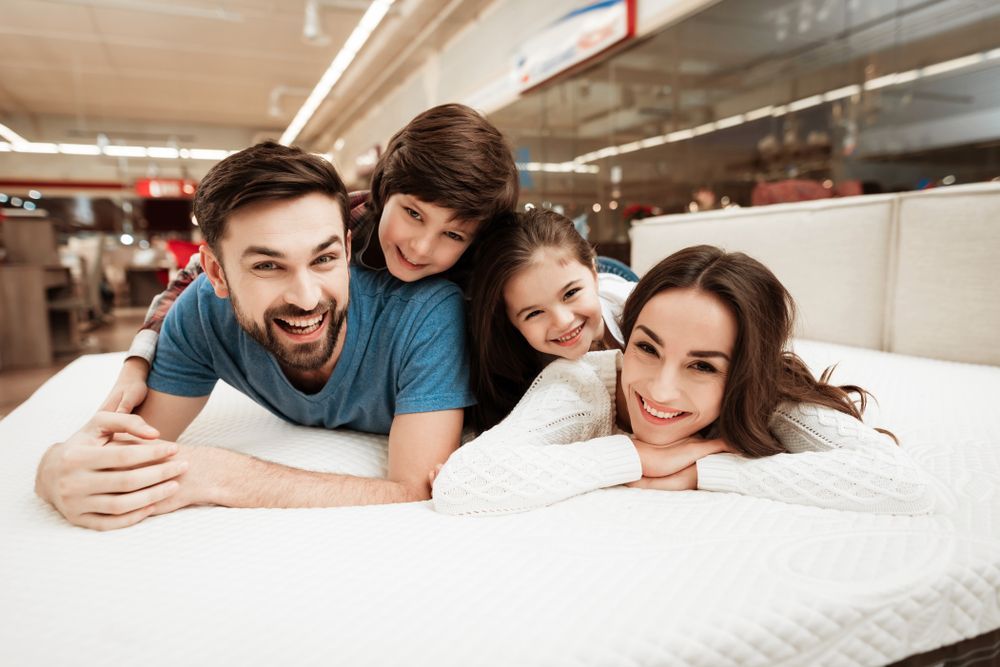
Is your mattress five or more years old? Have you noticed your home mattress is lumpy while hotel beds are more comfortable than not? It might be time to get yourself a new mattress to get back to your restful sleep each night. Getting Started Before you head out and purchase a new mattress, there are quite a few things you'll need to consider first. The first is what size you will need; consider that you shift around in the middle of the night, so having too small a bed would make it difficult to move around as needed. Standard sizes include twin, double, queen, California king and king. Once you arrive at the store, don't think twice about laying down on the mattress to test it out; the mattresses are out for this very purpose. Bring shoes that can easily be slipped off and get on the mattress, testing each side for five minutes. Panelists of a survey who brought home a bed for a month trial very rarely changed their minds about the bed after the first night, and their opinions are typically the same as those who test mattresses in the stores. Types of Mattresses Most people tend to have an innerspring bed that, by now, has likely worn out. Fortunately, it is not too costly to get a new one or even one of a different kind; in most cases, all but the cheapest beds are pretty sturdy, so you can shop more based on type rather than price. The innerspring mattresses are the ones with the steel coils on the inside. They are sold most often, partially because they are the least expensive to purchase. Some variations can include additional layers of infused gel or other kinds of cushioning. The top sellers of innerspring mattresses are Spring Air, Simmons, Sealy and Serta. Gel mattresses have a flexible substance that typically makes it more useful as a layer for another kind of bed. Inflatable air mattresses permit you to inflate it up to the point of your desired firmness. There are numerous variations of this that can include more layers like foam. Memory foam mattresses are polyurethane-based and are a favorite of many panelists who have tried them out. There is also latex foam, which is supposedly hypoallergenic, making it useful for those who suffer from allergies. Features The way a mattress feels when you sleep ultimately depends on how it was constructed. Many stores offer a cross-section display of some of the mattresses they sell in order to provide some insight for the construction. Of course, there is still no single best bed for everyone, so it's worth researching the features that you will find the best for your needed support. The outermost layer is the ticking, and it's usually cotton-polyester. Fancier types will have microsuede, wool, silk or cashmere. This also contributes to comfort during sleep; specifically, the stitching that binds the padding to the ticking will affect how you feel on the mattress. Large quilt patterns offer cushioning while smaller ones feel more firm. The top padding is often polyurethane foam, and "egg crate" foam feels softer than a full slab of foam. In a conventional mattress, the coils are the primary support inside. Heavier coils are stiffer, and lighter coils are springier. Despite all this, all coils are able to hold their own in a mattress. Manufacturers tend to add coils to the sides, which can stop you from feeling as if though you are about to roll off. Though it sells nearly as much as the mattress, the box spring is typically just wood enclosing wire. Manufacturers tend to pair the spring foundation with mattresses, so you might be able to save by getting a higher-end mattress with a cheap foundation. Those interested in getting a very thick mattress may want a box spring with a low profile so that the bed is not too high. In addition, despite the name, there is no spring to the box springs; they are simply there in order to support the mattress itself. Toppers tend to be sold separately, but they're designed to be on top of a mattress. It can soften a bed that is too firm, and the price has no bearing on quality of sleep. For example, a $900 topper could feel too soft while a cheap $30 topper might be just right. Of course, with the right mattress, a topper just is not necessary. Brands There are many different brands of mattresses, and model numbers will vary depending on the store that you go to. However, when you are going mattress shopping, you may come across some of these popular names. Tempur-Pedic introduced memory foam many years ago, and it is the leading specialty sleep brand among its kind. It offers a rather expensive line of proprietary bedding, starting at $1200 for the queen and up to $6000 for its GrandBed. Serta is the leader of all mattresses, relying on its "counting sheep" ads to get its point across to prospective customers. A national brand available at many local stores, prices can range from its entry level $200 queen mattress to $3000 for a memory-foam model. Select Comfort is another specialty brand that has grown considerably lately. It is most known for its Sleep Number beds to help provide just the right amount of comfort for both people on the bed. Prices range considerably with this brand.
Read next


Refrigerator Shopping Guide

